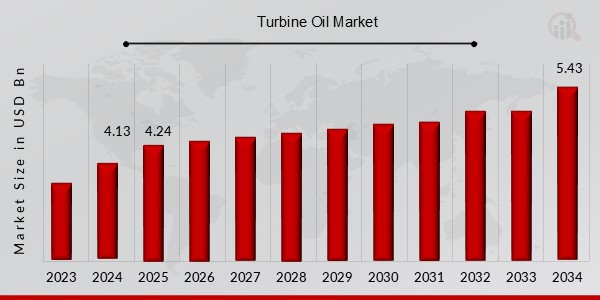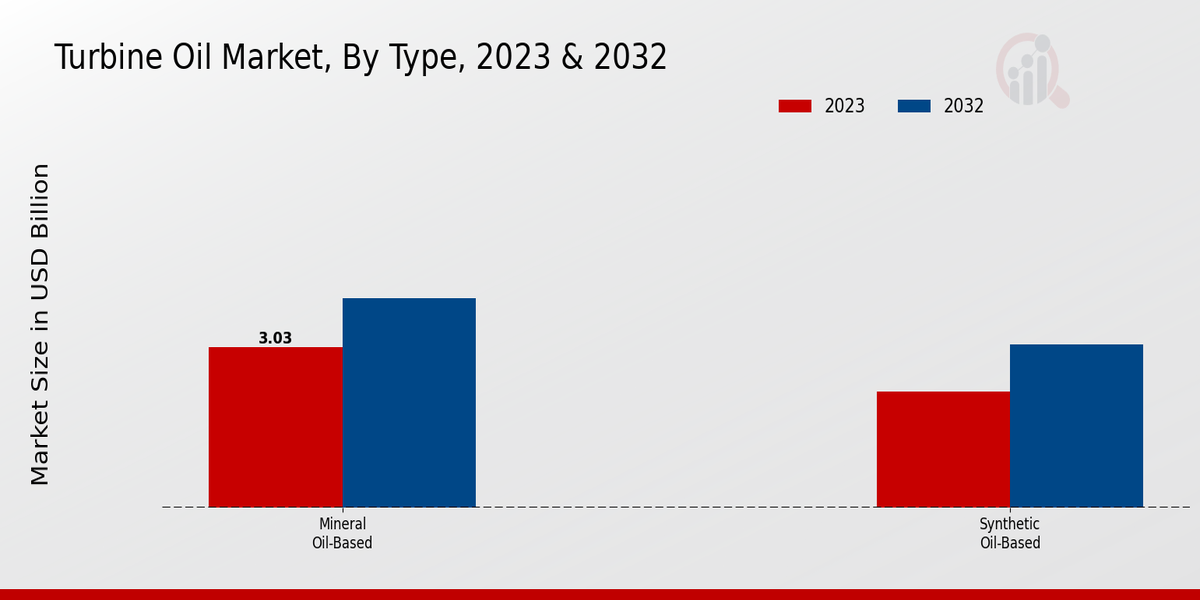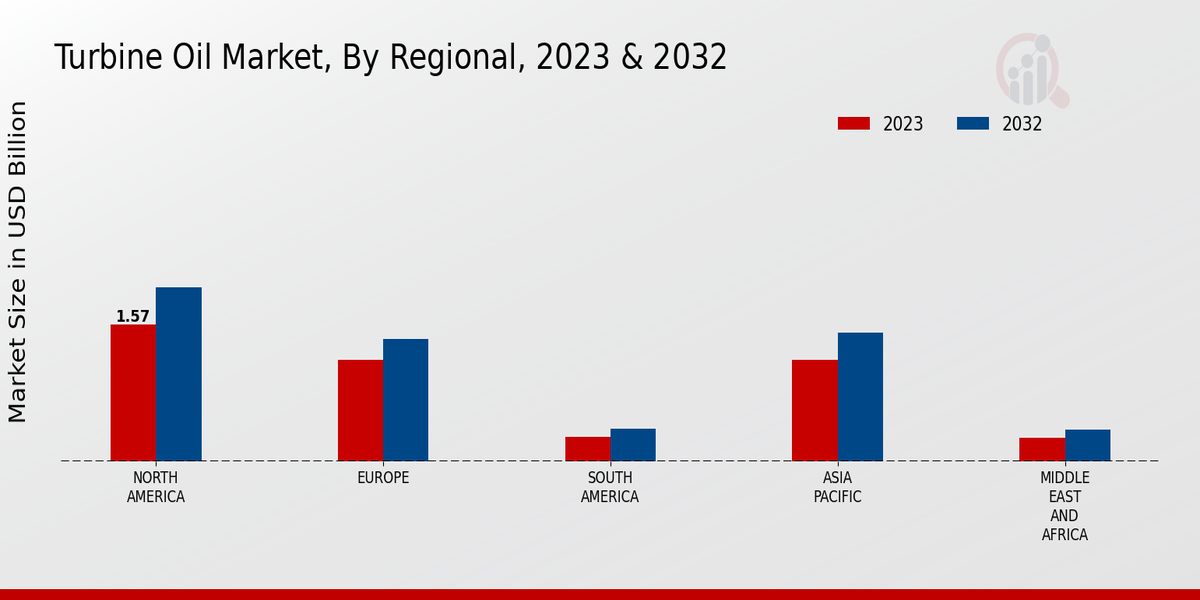Global Turbine Oil Market Overview
The Turbine Oil Market Size was estimated at 4.13 (USD Billion) in 2024. The Turbine Oil Industry is expected to grow from 4.24 (USD Billion) in 2025 to 5.43 (USD Billion) by 2034. The Turbine Oil Market CAGR (growth rate) is expected to be around 2.78% during the forecast period (2025 - 2034).
Key Turbine Oil Market Trends Highlighted
The Turbine Oil Market is anticipated to grow significantly in the coming years due to rising demand from various industries, including power generation, manufacturing, and aviation. Major market trends include the increasing adoption of renewable energy sources, which require efficient lubricants for turbines in wind and solar power plants. Additionally, the growing focus on environmental sustainability is driving the demand for bio-based and biodegradable turbine oils. Furthermore, advancements in turbine technology, such as the development of high-temperature and high-pressure turbines, are creating opportunities for specialized turbine oils that can meet the unique performance requirements of these systems.

Source: Primary Research, Secondary Research, MRFR Database and Analyst Review
Turbine Oil Market Drivers
Growing Demand for Energy-Efficient Solutions
The rising need for energy efficiency in various industries, including power generation, manufacturing, and transportation, is driving the demand for turbine oils. Turbine oils play a crucial role in reducing friction and wear in turbines, thereby improving their efficiency and extending their lifespan. Stringent government regulations and increasing awareness about environmental sustainability are further fueling the demand for energy-efficient solutions, which is expected to positively impact the Turbine Oil Market growth. Moreover, the increasing adoption of renewable energy sources, such as wind and solar, is anticipated to create new opportunities for turbine oil manufacturers, as these systems require specialized lubricants to ensure optimal performance.
Rising Adoption of Gas Turbines
The growing adoption of gas turbines in power generation and other industrial applications is expected to boost the demand for turbine oils. Gas turbines offer several advantages, including high efficiency, low emissions, and flexibility in fuel usage, making them an attractive option for power generation. The increasing demand for electricity and the need for cleaner energy sources are driving the adoption of gas turbines, which, in turn, is expected to contribute to the growth of the turbine oil market.
Technological Advancements and Innovation
Ongoing technological advancements and innovations in the turbine oil industry are expected to further drive market growth. Research and development efforts are focused on developing new turbine oils with improved properties, such as higher thermal stability, longer oil life, and enhanced anti-wear characteristics. The introduction of synthetic turbine oils and the development of condition monitoring systems are some of the key innovations shaping the Turbine Oil Market Industry.These advancements are aimed at meeting the evolving needs of turbine operators and improving the overall performance and reliability of turbines.
Turbine Oil Market Segment Insights
Turbine Oil Market Type Insights
The Turbine Oil Market is segmented by Type into Mineral Oil-based and Synthetic Oil-based. Mineral Oil-based Mineral oil-based turbine oils are derived from refined crude oil and are the most commonly used type of turbine oil due to their low cost and good performance. They are characterized by their high viscosity, which helps to maintain a lubricating film between moving parts, and their ability to withstand high temperatures. However, mineral oil-based turbine oils can be susceptible to oxidation and degradation, which can lead to the formation of sludge and deposits.Synthetic Oil-based Synthetic oil-based turbine oils are manufactured from synthetic hydrocarbons and offer several advantages over mineral oil-based oils. They have a higher viscosity index, which means that they maintain their viscosity over a wider temperature range, and they are more resistant to oxidation and degradation. Synthetic oil-based turbine oils are also more thermally stable, which means that they can withstand higher temperatures without breaking down. However, they are more expensive than mineral oil-based oils. The choice between mineral oil-based and synthetic oil-based turbine oils depends on the specific application and operating conditions. The growth of the market is attributed to the increasing demand for turbine oils from the power generation, manufacturing, and mining industries.
Source: Primary Research, Secondary Research, MRFR Database and Analyst Review
Turbine Oil Market Application Insights
The application segment of the Turbine Oil Market is categorized into Industrial Turbines and Aero-derivative Turbines. Industrial Turbines held the largest market share in 2023, accounting for nearly 60% of the Turbine Oil Market revenue. The growth of this segment is attributed to the increasing demand for electricity and the need for efficient and reliable power generation. Aero-derivative Turbines are expected to witness significant growth over the forecast period due to their increasing adoption in the aerospace industry. The growth of this segment is driven by the rising demand for fuel-efficient and high-performance aircraft engines. Overall, the Turbine Oil Market is expected to witness steady growth in the coming years, driven by the increasing demand for electricity and the growing aerospace industry.
Turbine Oil Market Usage Insights
The Turbine Oil Market segmentation by Usage includes Medium-Pressure Turbines and High-Pressure Turbines. Medium-pressure turbines held a larger market share in 2023 and are expected to continue their dominance throughout the forecast period. The segment's growth can be attributed to the increasing demand for medium-pressure turbines in power generation applications. High-pressure turbines are anticipated to witness a significant growth rate during the forecast period due to their rising adoption in industrial applications, particularly in the oil and gas sector. The Turbine Oil Market revenue for Medium-Pressure Turbines is projected to reach USD 1.6 billion by 2032, growing at a CAGR of 2.5%. The Turbine Oil Market revenue for High-Pressure Turbines is estimated to reach USD 2.4 billion by 2032, registering a CAGR of 3.1%.
Turbine Oil Market Additives Insights
The additives segment is crucial, accounting for a sizeable share of the Turbine Oil Market revenue. Among the various additives, antioxidants, anti-wear additives, and demulsifiers hold significant importance. Antioxidants protect turbine oils from degradation caused by oxidation, extending their lifespan. Anti-wear additives reduce friction and wear on turbine components, improving efficiency and reducing maintenance costs. Demulsifiers prevent the formation of emulsions between turbine oil and water, ensuring optimal lubrication and preventing system damage.The Turbine Oil Market segmentation data indicates a steady growth in the demand for these additives, driven by the increasing need for efficient and reliable turbine operations. The market statistics show that the additives segment is expected to witness significant growth over the forecast period, contributing to the overall expansion of the Turbine Oil Market industry.
Turbine Oil Market Performance Standard Insights
The Performance Standard segment of the Turbine Oil Market is categorized by the adherence to industry-specific standards that define the performance and quality requirements for turbine oils. Key standards include ISO 11158, DIN 51515, and ASTM D4304. These standards provide guidelines for various parameters, including oxidation stability, demulsibility, water separation, and additive content. The Turbine Oil Market revenue for the Performance Standard segment is projected to reach USD 2.4 billion by 2024, accounting for approximately 45% of the overall market share.The increasing adoption of these standards is driven by the need for reliable and efficient operation of turbines in various industries, including power generation, manufacturing, and aviation. The demand for turbine oils meeting these standards is expected to grow steadily in the coming years, supported by the increasing number of gas and steam turbines being installed globally.
Turbine Oil Market Regional Insights
The Turbine Oil Market segmentation by region includes North America, Europe, APAC, South America, and MEA. The North American region is expected to hold the largest market share in 2023, owing to the presence of a significant number of power plants and industrial facilities in the region. The European region is expected to witness significant growth over the forecast period due to increasing demand from the energy and manufacturing sectors. The APAC region is expected to be the fastest-growing region over the forecast period, driven by rapid industrialization and economic growth in countries such as China and India.The South American and MEA regions are expected to contribute a smaller share of the Turbine Oil Market revenue but are expected to witness stable growth over the forecast period.

Source: Primary Research, Secondary Research, MRFR Database and Analyst Review
Turbine Oil Market Key Players And Competitive Insights
Major players in the Turbine Oil Market industry are constantly striving to outdo each other in terms of innovation and technological advancements. Leading Turbine Oil Market players are focusing on developing eco-friendly and biodegradable Turbine Oil Market solutions to cater to the growing demand for sustainable products. Partnerships and collaborations are becoming increasingly common as companies seek to expand their market reach and share new developments. The Turbine Oil Market development landscape is characterized by a mix of established players and emerging entrants, each trying to gain a competitive edge. The Turbine Oil Market Competitive Landscape is expected to remain dynamic in the coming years, driven by the evolving needs of end-use industries.ExxonMobil, a leading company in the Turbine Oil Market industry, has been at the forefront of innovation and technological advancements. The company's focus on research and development has led to the development of advanced Turbine Oil Market solutions that meet the specific needs of various industries. ExxonMobil's commitment to sustainability is reflected in its efforts to develop environmentally friendly Turbine Oil Market products. The company's strong global presence and extensive distribution network provide it with a competitive advantage in the Turbine Oil Market.BP, a major competitor in the Turbine Oil Market industry, has also been making significant investments in research and development. The company's focus on developing high-performance Turbine Oil Market solutions has helped it gain a strong position in the market. BP's commitment to customer service and technical support has further enhanced its reputation among end-users. The company's global reach and extensive product portfolio allow it to cater to a wide range of customer needs.
Key Companies in the Turbine Oil Market Include
- Sinopec Corp.
- China National Petroleum Corporation
- TotalEnergies
- Indian Oil Corporation Limited
- ChevronPhillips Chemical
- China Petroleum Chemical Corporation
- Petrobras
- ExxonMobil
- Shell plc.
- BP plc.
- Saudi Aramco
- Gazprom Neft
- JX Nippon Oil Energy Corp.
- Idemitsu Kosan Co., Ltd.
Turbine Oil Market Industry Developments
The Turbine Oil Market is expected to reach a value of USD 5.0 billion by 2032, exhibiting a CAGR of 2.78% during the forecast period 2024-2032. This growth is attributed to the increasing demand for turbines in power generation, aviation, and industrial applications.Recent developments in the market include the launch of new products by key players, such as Shell's launch of its new high-performance turbine oil, Shell Turbine Oil S6 GX. Additionally, government initiatives to promote the adoption of renewable energy sources, such as the US government's tax credits for wind and solar power, are expected to drive demand for turbine oil in the coming years.
Turbine Oil Market Segmentation Insights
- Turbine Oil Market Type Outlook
- Mineral Oil-based
- Synthetic Oil-based
- Turbine Oil Market Application Outlook
- Industrial Turbines
- Aero-derivative Turbines
- Turbine Oil Market Usage Outlook
- Medium-Pressure Turbines
- High-Pressure Turbines
- Turbine Oil Market Additives Outlook
- Antioxidants
- Anti-wear Additives
- Demulsifiers
- Turbine Oil Market Performance Standard Outlook
- ISO 11158
- DIN 51515
- ASTM D4304
| Report Attribute/Metric |
Details |
| Market Size 2024 |
4.13 (USD Billion) |
| Market Size 2025 |
4.24 (USD Billion) |
| Market Size 2034 |
5.43 (USD Billion) |
| Compound Annual Growth Rate (CAGR) |
2.78% (2025 - 2034) |
| Report Coverage |
Revenue Forecast, Competitive Landscape, Growth Factors, and Trends |
| Base Year |
2024 |
| Market Forecast Period |
2025 - 2034 |
| Historical Data |
2020 - 2024 |
| Market Forecast Units |
USD Billion |
| Key Companies Profiled |
Sinopec Corp., China National Petroleum Corporation, TotalEnergies, Indian Oil Corporation Limited, ChevronPhillips Chemical, China Petroleum Chemical Corporation, Petrobras, ExxonMobil, Shell plc., BP plc., Saudi Aramco, Gazprom Neft, JX Nippon Oil Energy Corp., Idemitsu Kosan Co., Ltd. |
| Segments Covered |
Type, Application, Usage, Additives, Performance Standard, Regional |
| Key Market Opportunities |
Renewables Decarbonization Automation Digitalization Industrialization |
| Key Market Dynamics |
Increasing demand for renewable energy, stringent environmental regulations, technological advancements, growing industrialization, and rising urbanization |
| Countries Covered |
North America, Europe, APAC, South America, MEA |
Frequently Asked Questions (FAQ) :
The Turbine Oil Market is anticipated to reach a valuation of approximately 4.24 billion USD in 2025.
The Turbine Oil Market is estimated to expand at a CAGR of 2.78% from 2025 to 2034.
The Asia-Pacific region is projected to account for the largest share of the Turbine Oil Market in 2023.
Turbine Oil is primarily utilized in gas and steam turbines for lubrication, cooling, and protection against wear and corrosion.
Prominent players in the Turbine Oil Market include ExxonMobil, Chevron, Shell, BP, and TotalEnergies.
The Turbine Oil Market is projected to reach an estimated value of 5.43 billion USD by 2034.
The power generation industry is the primary consumer of Turbine Oil, utilizing it in turbines for electricity production.
Growing demand for electricity, increasing adoption of renewable energy sources, and technological advancements in turbine design are driving the growth of the Turbine Oil Market.
Fluctuating raw material prices, stringent environmental regulations, and competition from alternative lubricants pose challenges to the Turbine Oil Market.
Advancements in synthetic lubricants, the development of eco-friendly Turbine Oils, and the integration of IoT technologies are emerging trends in the Turbine Oil Market.
















